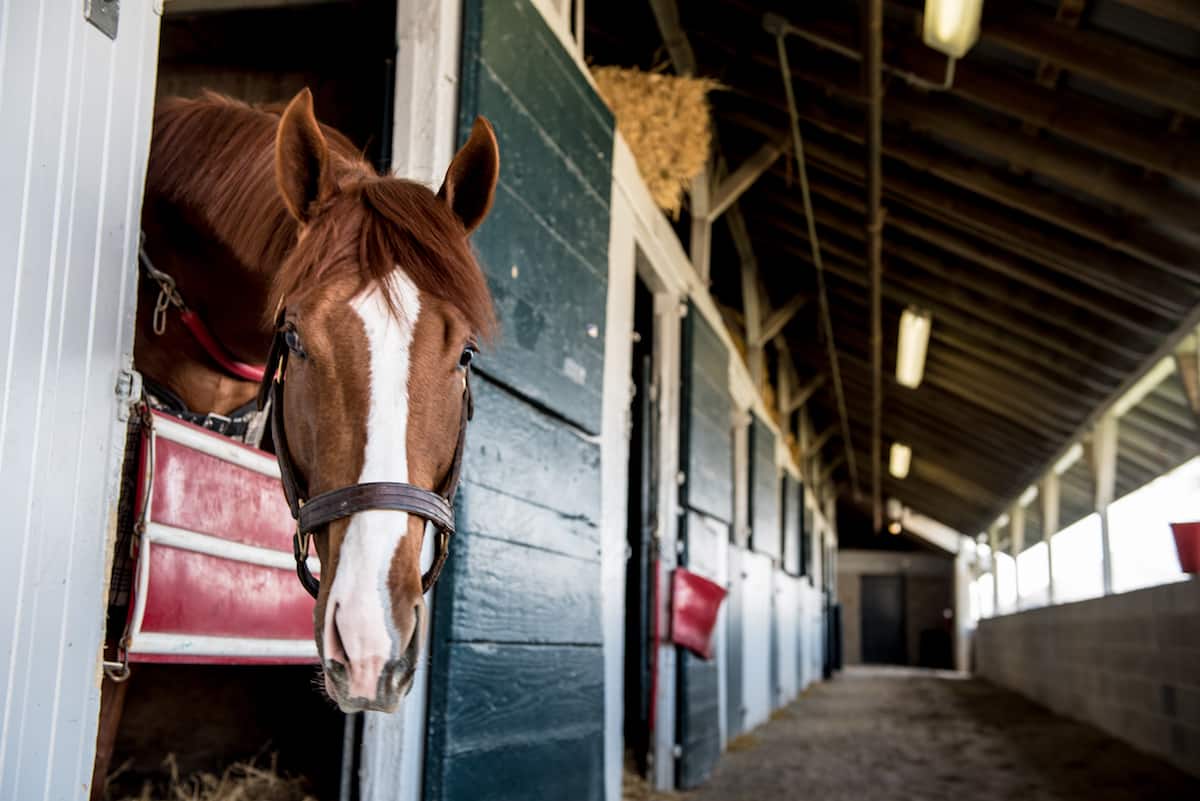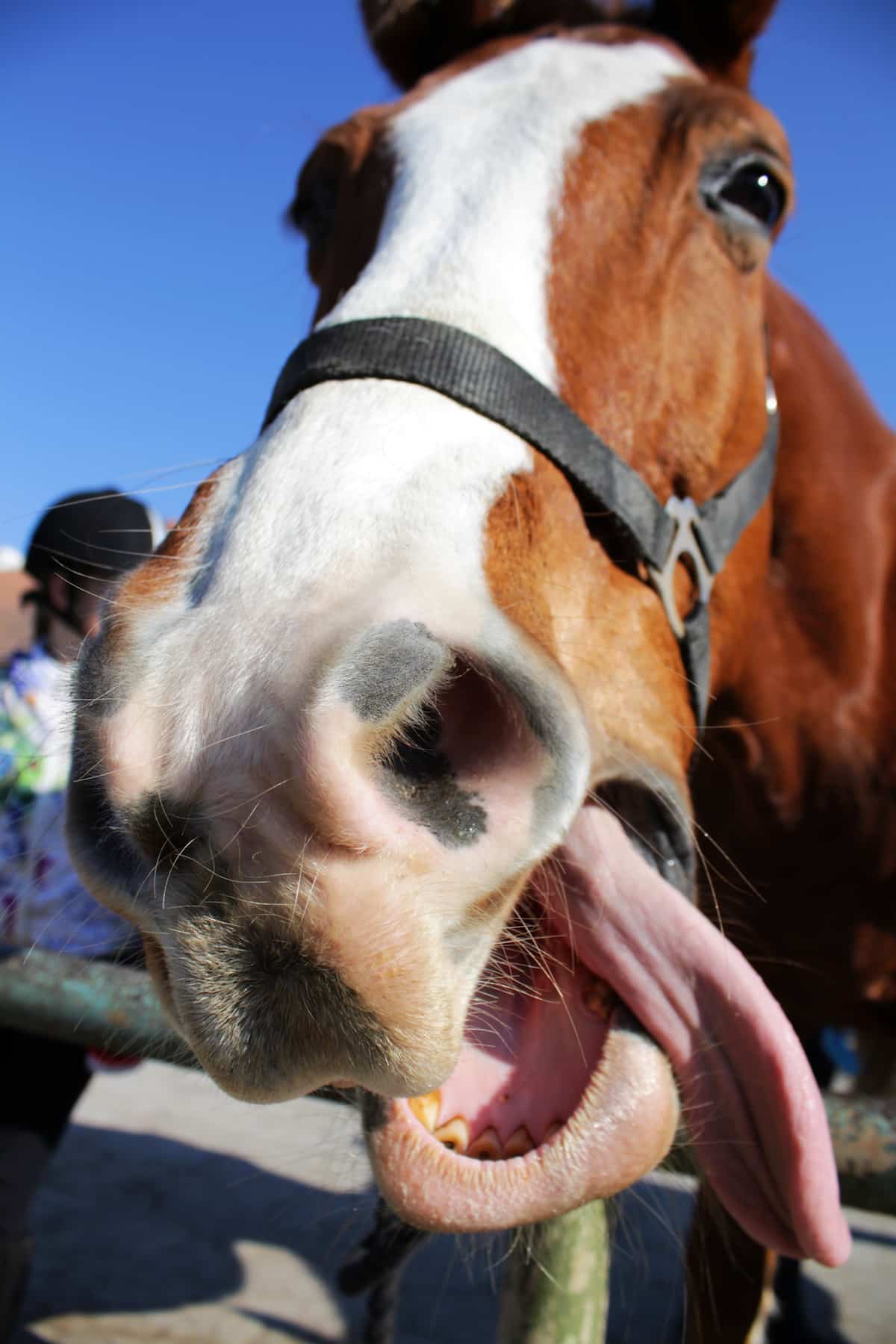Commonly called “stable vices,” these are more than bad habits but not necessarily a reason to pass on a prospect

Modifications to racehorse management on the track, such as providing round-the-clock forage and open stall doors, might help prevent stereotypies from developing in the first place. Courtesy Flickr CC by Carine06
Advertisements for Thoroughbreds coming off the track usually list the horse’s age, color, height, pedigree, race record and any injuries. They often also include a statement of “no vices” or, conversely, no mention about the horse’s behavior at all. The omission might mean the horse exhibits an undesirable or abnormal behavior; whether it’s cribbing, weaving, teeth-grinding or something else, you’d have to ask the seller specifically.
But experts agree, vice isn’t the right word for these behaviors, which are actually stereotypic — ones that are repetitive, invariant and serve no obvious goal or function. And a stereotypic behavior alone isn’t necessarily a reason to say “pass” to a prospect.
To learn more, we talked to Camie Heleski and Carissa Wickens, both PhDs and horse behavior experts with experience in the racing industry. Heleski is a senior lecturer in equine programs at the University of Kentucky, in Lexington — the heart of Thoroughbred country. She was also a licensed exercise rider and trainer of Arabian racehorses. Wickens is an assistant professor and equine extension specialist at the University of Florida, in Gainesville, whose research has included Thoroughbred aftercare, as well as stereotypic behaviors, specifically cribbing.
Vice vs. Stereotypic Behavior: What’s the Difference?
Vice is a common word in the horseperson’s lexicon. No doubt you’ve seen it used to describe a laundry list of unwanted or undesirable behaviors in horsemanship manuals and magazines and on websites. But the literal definition of vice is a “wicked or immoral behavior,” so using the word can lead to misunderstanding of horses’ motivations and adversely affect equine welfare, Heleski says.
“It has a negative connotation, like how smoking is often seen as a vice in humans,” says Heleski, who adds that using the word places unfair blame on the horse. In reality, she says, these horses likely develop the behaviors in response to their environment and lifestyle.
Stereotypic behaviors are sometimes seen in zoo animals. Examples include polar bears that constantly pace in their enclosures or elephants swinging their trunks incessantly while shifting weight from one front foot to the other. Stereotypic behaviors in caged parrots include self-mutilation and feather plucking. Notably, these behaviors don’t occur for these species in the wild, which can give clues as to their root causes (more on that in a bit).
Heleski says most common stereotypic behaviors in OTTBs fall into two categories:
1. Oral. These can include cribbing and tongue or lip play.
Cribbing, also called wind-sucking, is the act of biting an object (usually a fence board or stall edge) and forcibly sucking in air. Cribbing can cause significant wear or damage to the horse’s incisors (front teeth). Don’t confuse cribbing with wood-chewing, warns Heleski. While wood-chewing is destructive, and many people find it irritating, “it’s a natural foraging behavior,” she says, and doesn’t fall under the stereotypic umbrella.
Teeth-grinding, as the name implies, is the act of grinding the teeth together forcibly, usually resulting in an audible sound.
Tongue and lip play can include behaviors such as tongue lolling or twisting and lip-flipping. In calves tongue play is related to suckling behavior.
2. Locomotive, involving bodily movement, include stall-walking, weaving and head circling or flipping.
Stall walkers move around their stall constantly. When not allowed to be ambulatory (such as when tied), the horse might resort to marching in place, which can turn into the next stereotypic behavior.
Weaving involves standing in place while swinging the head and neck laterally and shifting weight between the front feet. While it can be associated with stall-walking, it can exist on its own, as well.
Self-mutilation is less common and mostly occurs in stallions, probably due to social isolation. This involves the horse biting itself repeatedly, usually on the chest, shoulders or flanks.
What Isn’t a Stereotypic Behavior?
A stereotypic behavior is not a learned behavior the horse repeats in response to a perceived reward, outcome or reaction. Heleski uses pawing at mealtime as an example of an unwanted behavior some consider a vice that isn’t stereotypic. In this case, the horse has associated the act of pawing (a behavior horses use to find grass or water under snow and ice) with food delivery, a natural association, which in turn reinforces (or rewards) the pawing. The next time the horse wants food, he paws because he has learned the pawing results in food delivery.
Biting, kicking and striking (at a person, horse or other animal/object) in ways that are defensive and elicit a reaction aren’t stereotypic behaviors, either. These are also likely learned and reinforced or might be performed in response to pain associated with a physical problem (e.g., gastric ulcers, back pain, etc.), says Wickens, and don’t fulfill the “repetitive” and “without an obvious goal or function” definition of stereotypic behaviors.
How Stereotypies Develop
So, we know wild animals develop stereotypic behaviors when they’re housed in captivity with limited social interactions and few enrichments (activities that challenge the brain and body). Heleski suspects environment plays a role in the development of stereotypic behaviors in horses, as well.
“Horses need the three ‘Fs’: Freedom to move, forage and friends,” says Heleski, who credits equine behaviorist Lauren Fraser with coining the concept. If those are limited, horses can be at risk for developing stereotypic behaviors.
A competitive lifestyle — one that includes peak fitness, high-energy diets and confinement — can put race- and show horses at risk. At the track horses often eat highly concentrated meals rather than pasture and have limited to no turnout time. Most racetrack stalls have solid walls to help prevent the spread of infections; these also prevent horses from seeing each other and having social contact. Distress from gastric ulcers — which are prevalent in more than 90 percent of racehorses — can compound the problem, Wickens says.
Other high-stress life events, such as weaning and stall rest after injury, increase the chances a horse will develop stereotypic behaviors, Heleski says.
On the other hand, Heleski adds, “You can do everything wrong with a specific horse and never have a stereotypic behavior develop.”
That’s because environment isn’t the only factor: Researchers believe some horses have genetic predispositions to stereotypic behavior, which is why they might occur more commonly in certain breeds, including Thoroughbreds, Wickens says.
Additionally, Heleski sees more racing trainers modifying their management at the track in ways that might reduce stereotypic behavior occurrence. For example, many horses at the track have access to forage in haynets around the clock and are kept with their stall doors open in a way that allows them to see and interact with other horses, she says.

Teeth-grinding, tongue or lip play and cribbing are oral stereotypies — the latter of which is typically the most frustrating to deal with. Courtesy istock.com
Is Stereotypic Behavior a Deal-Breaker?
So, if the OTTB prospect you’re considering exhibits a stereotypic behavior, should you pass or take a chance?
That depends on your needs and plans for the horse. If it’s a resale project, a behavior such as cribbing might lower the horse’s future price. Heleski and Wickens have participated in a yet-unpublished survey of Thoroughbred rehoming programs that preliminarily indicates horses with stereotypic behaviors — especially cribbers — have lower initial sale or adoption prices. However, those prices might stabilize once a horse has been restarted and establishes a new career and show record.
“My advice is to consider the horse’s overall health, athletic ability and behavior,” Wickens says. Desirable breeding or exceptional movement might just outweigh a horse’s tendency to crib or weave, for instance.
She adds that management changes can help horses with certain stereotypic behaviors, especially locomotive ones. Things like stall-walking and weaving might lessen or seemingly disappear if the horse is turned out more, given access to friends and housed in stalls with dividers that allow horses to see each other.
Oral stereotypic behaviors seem to be “stickier” for some horses, Heleski says. For example, while a pastured horse’s cribbing might diminish, you’re unlikely to extinguish it completely, she says.
Although management can modify some stereotypic behaviors, impeding behaviors through physical prevention (i.e., a collar to stop cribbing or tying to prevent stall-walking) or punishment does little to help, Wickens says. In fact, these approaches can make things worse. For example, inhibiting cribbing can cause a rebound effect, making the behavior more frequent when the collar is removed.
Take-Home Message
Stereotypic behaviors develop in certain horses when they have limited social interaction, turnout and forage. A genetic component, combined with stresses inherent in a competitive environment, might make Thoroughbreds more prone to developing stereotypic behaviors. However, some of the behaviors will ebb with management changes.
This article was originally published in the Winter 2019 issue of Off-Track Thoroughbred Magazine, the only publication dedicated to the Thoroughbred ex-racehorse in second careers. Want four information-packed issues a year delivered to your door or your favorite digital device? Subscribe now!

